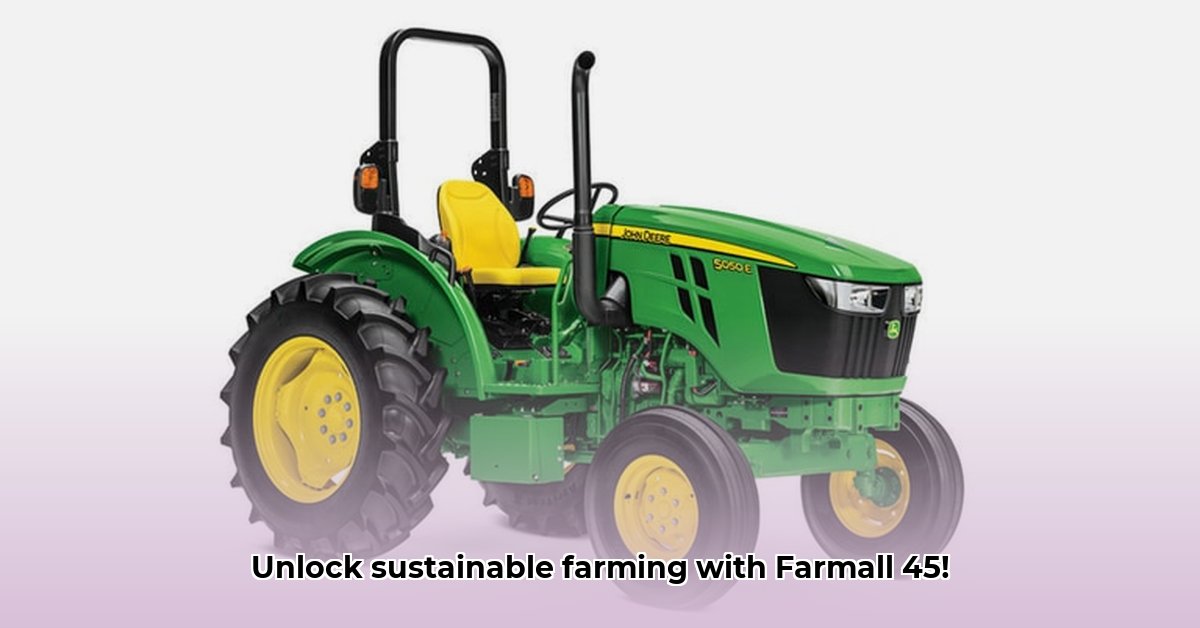
Getting Started: The Case IH Farmall 45 and Sustainable Agriculture
The Case IH Farmall 45, a compact tractor designed for smaller farms, is gaining traction among environmentally conscious farmers. For more detailed specifications, visit the Farmall 45 site. This detailed review, incorporating instructional guide elements, will assess its suitability for sustainable farming practices. We'll explore its technical specifications, performance, sustainability impact, and practical application, providing actionable advice for maximizing its efficiency and minimizing its environmental footprint.
Technical Specifications and Features
The Farmall 45 boasts a robust 2.2-liter, four-cylinder diesel engine, generating approximately 45 horsepower (depending on configuration). 1 Transmission choices include hydrostatic and continuously variable transmission (CVT) options—offering flexibility in speed control. A mid-PTO (power take-off) allows for the use of various implements, increasing its versatility. A front-end loader is available as an optional attachment, further enhancing its functionality for diverse farming tasks. These features make it a viable option for a range of small-scale farming operations. However, its horsepower limitation restricts its suitability for heavy-duty applications.
Performance Analysis: Fuel Efficiency and Power Output
While precise fuel consumption data per acre for various tasks are currently limited, the Farmall 45's smaller engine suggests improved fuel efficiency compared to larger tractors. This translates to lower operating costs and reduced greenhouse gas emissions. However, its lower power output necessitates careful task selection and matching of implements to avoid overloading, which can negate fuel efficiency gains. For example, heavy plowing might prove too demanding for this tractor's capabilities. How efficiently can you till an acre with this tractor compared to other compact tractors? This question demands further research for a clear answer.
Sustainability Assessment: Evaluating the Environmental Impact
Assessing the Farmall 45's full environmental impact requires a comprehensive lifecycle analysis (LCA), considering manufacturing, operation, and disposal. While data on its carbon footprint are currently scarce, we can infer that the fuel efficiency contributes to reduced emissions during operation. The tractor's size and weight minimize soil compaction, promoting soil health; a crucial aspect of sustainable agriculture. However, the longevity of the tractor and the recyclability of its components need further research to complete the sustainability picture.
"A complete LCA is crucial for a holistic view of a tractor's environmental impact. Without it, we are only seeing part of the picture," says Dr. Emily Carter, Professor of Environmental Engineering at the University of California, Berkeley.
Practical Application and Instructional Guide
This section provides actionable steps to effectively utilize the Farmall 45 for sustainable farming:
Choosing the Right Configuration: Carefully assess your farming needs before purchasing. Consider whether you require a front-end loader and the most suitable transmission type for your terrain and operations. This initial decision will significantly impact both efficiency and overall cost.
Implementing a Robust Maintenance Schedule: Regular maintenance is paramount. Adhering to the manufacturer's recommended schedule (oil changes, filter replacements, etc.) will significantly extend the tractor's lifespan and minimize downtime. A well-maintained machine equates to both cost and environmental savings.
Matching Implements to the Task: Ensure compatibility between the Farmall 45 and any implements before purchase. Using unsuitable equipment can lead to damage and inefficiencies. Research thoroughly to make informed choices.
Exploring Financing Options: Investigate available financing plans and government subsidies to reduce the initial investment costs, particularly those related to sustainable farming initiatives.
Integrating Precision Agriculture Technologies: Explore compatible GPS guidance and auto-steer systems to increase operational precision, reducing overlaps and optimizing resource use. Before implementation, verify compatibility for seamless integration.
Comparative Analysis: A Future Perspective
Direct comparisons with similar compact tractors await further data collection. A thorough comparative analysis, incorporating metrics such as fuel consumption per acre for various tasks and long-term maintenance costs, is essential for a comprehensive evaluation. Future updates will include this critical comparative data once it becomes available.
Conclusion: Sustainability and the Farmall 45
The Case IH Farmall 45 presents a viable option for small-scale, sustainable farming operations. Its potential for fuel efficiency, minimized soil compaction, and compatibility with precision agriculture technologies are significant benefits. However, the lack of comprehensive lifecycle analysis data currently limits a definitive conclusion on its overall sustainability. Further research is necessary to fully assess its environmental impact. Careful consideration of individual farming needs, meticulous maintenance, and the responsible selection of precision agriculture practices will optimize both the tractor's performance and its contribution to a sustainable farming model.